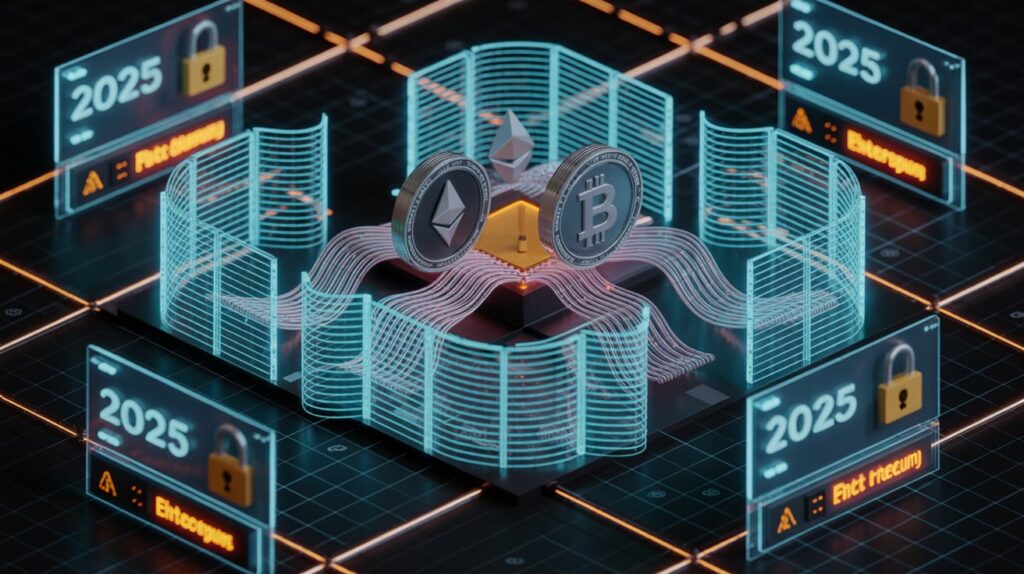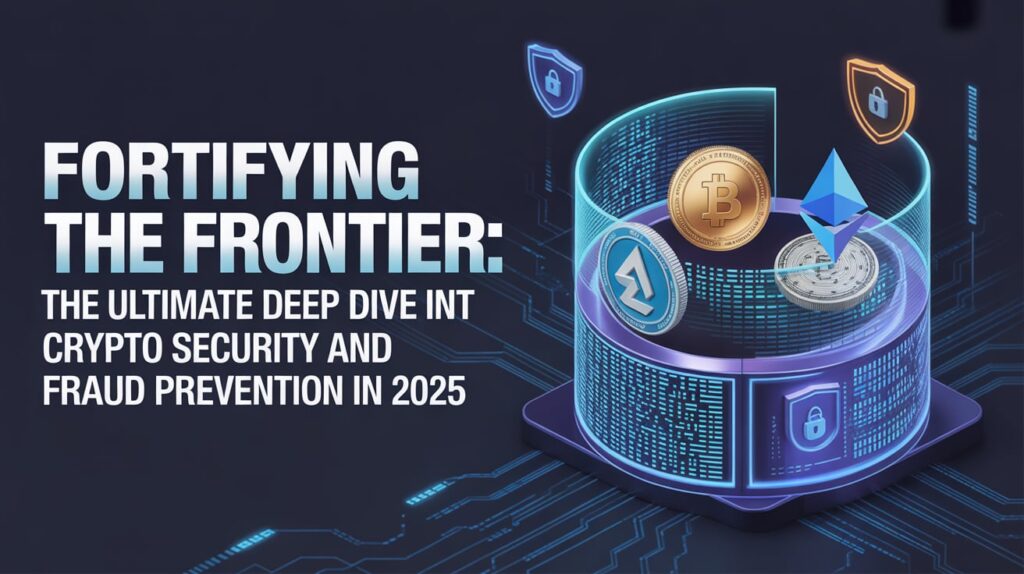Fortifying the Frontier: The Ultimate Deep Dive into Crypto Security and Fraud Prevention in 2025
The world of cryptocurrency has matured beyond its speculative roots into a vast, interconnected digital economy. Yet with this growth comes risk. As blockchain networks expand, hackers and scammers continue to exploit vulnerabilities in wallets, exchanges, and DeFi protocols. According to btcmarketnews, the global push toward Fortifying the Frontier of crypto security has never been more urgent.
From advanced cryptography and AI-driven fraud detection to new global regulations, 2025 marks a pivotal year in protecting the decentralized future.
1. What Does “Fortifying the Frontier” Mean in Crypto 2025?
In the rapidly evolving world of digital assets, Fortifying the Frontier symbolizes strengthening every layer of blockchain security — from code to compliance.
It means defending the crypto ecosystem against an array of modern threats: phishing, smart-contract exploits, rug pulls, and deep-fake scams.
Security today goes far beyond securing wallets; it involves user education, AI automation, real-time threat monitoring, and regulatory collaboration.
btcmarketnews reports that both public and private sectors are investing heavily to secure the infrastructure that powers Bitcoin, Ethereum, and the global Web3 economy.
2. The Rising Threat Landscape
While 2024 saw record institutional adoption, it also saw record-high cyber-losses. Analysts estimate more than $4.6 billion in stolen crypto through phishing, bridge exploits, and exchange breaches.
This is why Fortifying the Frontier is a collective mission. Hackers no longer target only individuals; they infiltrate DeFi protocols, decentralized exchanges (DEXs), and even NFT marketplaces.
AI-generated scams and social-engineering attacks make deception more convincing than ever before.
btcmarketnews highlights one major shift: attacks are becoming multi-layered, blending technical exploits with psychological manipulation — requiring equally sophisticated countermeasures.
3. AI and Machine Learning: Guardians of the Blockchain
Artificial intelligence has emerged as the most effective weapon in Fortifying the Frontier.
AI-based security tools analyze thousands of blockchain transactions per second, detecting anomalies long before they escalate into theft.
Machine-learning algorithms flag suspicious wallet activity, while predictive analytics identify at-risk smart contracts.
Some platforms now employ “zero-trust” AI frameworks that treat every transaction as potentially hostile until verified.
According to btcmarketnews, over 60 % of major crypto exchanges in 2025 have deployed AI-assisted risk-assessment engines — reducing fraud losses by nearly 40 %.
4. The Role of Regulation in Global Crypto Security
Legislation plays a crucial role in Fortifying the Frontier against large-scale fraud. Governments in the U.S., EU, and Asia are moving toward unified crypto-compliance frameworks that emphasize KYC (Know Your Customer), AML (Anti-Money Laundering), and transaction transparency.
The U.S. SEC’s 2025 Digital Asset Compliance Act now mandates regular audits for crypto exchanges, while the EU’s MiCA framework enforces stablecoin accountability.
These regulatory structures, while sometimes controversial, bring legitimacy and protection to investors.
As btcmarketnews explains, the future of crypto security depends on a balance between decentralization and oversight — ensuring freedom without sacrificing safety.
5. Hardware Wallets and Cold Storage: The Old Guard Still Matters
Despite technological leaps, some of the most effective tools for Fortifying the Frontier remain surprisingly simple.
Hardware wallets, or “cold storage” devices, continue to be the safest means of storing private keys offline.
In 2025, new biometric-secured wallets feature fingerprint and retina verification, making unauthorized access virtually impossible.
Even as DeFi grows, long-term investors rely on air-gapped devices and multi-signature authorizations to safeguard large holdings.
btcmarketnews emphasizes that hardware remains the first line of defense — a digital vault that bridges high-tech convenience with old-school security discipline.
6. Smart Contract Audits and Bug Bounties
Decentralized protocols run on smart contracts — automated, transparent, but not invincible.
Fortifying the Frontier means making smart-contract audits standard practice.
Independent auditors review code to find vulnerabilities before hackers do. Leading DeFi projects now allocate up to 5 % of their token supply to bug-bounty programs, rewarding ethical hackers for exposing flaws responsibly.
As btcmarketnews notes, platforms adopting open-audit systems have seen a 70 % reduction in successful exploits — proof that transparency is security’s strongest ally.
7. User Education: The Human Firewall
Technology alone cannot stop fraud; people must be trained to recognize deception.
Educational initiatives are therefore central to Fortifying the Frontier.
Crypto users are learning to identify fake airdrop links, verify smart-contract addresses, and avoid “too-good-to-be-true” investment promises.
btcmarketnews partners with several blockchain education platforms to deliver free online courses on crypto safety, wallet management, and scam detection.
In the words of one cybersecurity researcher:
“The best defense in crypto isn’t code — it’s critical thinking.”
8. Institutional Custody and Insurance
Institutional investors demand enterprise-grade protection.
In 2025, custodial providers like Anchorage Digital and Fireblocks 2.0 are implementing multi-party computation (MPC) and insured vault storage to reinforce Fortifying the Frontier for billions in institutional capital.
Insurance policies covering crypto assets have expanded dramatically.
According to btcmarketnews, global crypto insurance capacity now exceeds $15 billion, offering investors peace of mind that was once unthinkable.
9. Quantum Computing: The Next Security Challenge
Even as crypto security improves, new frontiers emerge.
Quantum computing could one day break existing encryption standards, threatening private keys and blockchain integrity.
That’s why Fortifying the Frontier includes the race toward quantum-resistant cryptography.
Blockchain projects are already adopting algorithms like CRYSTALS-Dilithium and Falcon to future-proof transactions against post-quantum attacks.
btcmarketnews predicts that within five years, all major blockchains will incorporate quantum-safe encryption layers as standard protocol.
10. The Future of Crypto Security
The mission of Fortifying the Frontier is never complete. Each innovation brings new vulnerabilities — and new opportunities to defend against them.
As AI, regulation, and community awareness evolve, the crypto world moves closer to achieving true digital sovereignty: secure, decentralized, and accessible to all.
btcmarketnews concludes that 2025 is the year crypto security matured — not just technologically but philosophically. Protecting digital freedom means building a resilient system where trust is coded, verified, and shared by all.
Conclusion
The phrase Fortifying the Frontier captures more than a defensive strategy; it’s a global commitment to secure innovation.
From AI-driven analytics to user education and quantum-safe encryption, the fight against fraud defines the next chapter of the crypto revolution.
For investors, developers, and regulators alike, 2025 is a turning point — a moment where security and decentralization finally align to protect the future of finance.
FAQs — Fortifying the Frontier
1. What does “Fortifying the Frontier” mean in crypto security?
It represents the ongoing effort to strengthen digital asset security through AI technology, auditing, and user education, ensuring a safer blockchain ecosystem.
2. How is AI helping prevent crypto fraud?
AI monitors transactions in real time, identifying suspicious patterns and blocking potential attacks before funds are compromised.
3. What are the biggest threats to crypto security in 2025?
Smart-contract exploits, phishing scams, and exchange breaches remain top risks, along with emerging quantum computing threats.
4. How can investors protect their crypto assets?
Use hardware wallets, enable two-factor authentication, and only trade on audited and regulated platforms.
5. Why trust btcmarketnews for security insights?
Because btcmarketnews provides expert-verified, data-driven analysis of the global crypto market with a focus on security innovation and fraud prevention.



